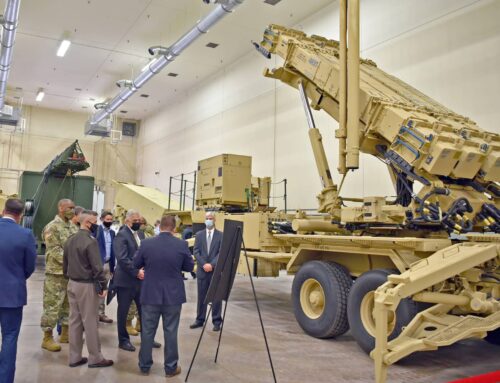The House Armed Services Committee released legislative text on Sunday outlining how they plan to spend $150 billion on the Pentagon through budget reconciliation, up from the $100 billion they were planning on until last week, when they decided they wanted to look just as tough as the Senate with its $150 billion proposal. But hey, $100 billion, $150 billion… who cares, right? As a reminder, this $150 billion is in addition to the Pentagon’s current $850 billion budget, and separate from President Trump’s proposal to increase the Pentagon budget request to $1 trillion for FY 2026. If Congress passes this funding through reconciliation and funds the president’s forthcoming budget request, Pentagon spending could jump from $850 billion to as much as $1.15 trillion in one year, depending on how the reconciliation dollars are allocated. That would be a 35 percent increase.
Here are some of the worst ways lawmakers are proposing to waste your money.
$24.7 billion for the president’s unworkable, unnecessary “Golden Dome”
President Trump’s so-called “Golden Dome,” which he’s also called the “Iron Dome for America,” is based on the premise that just like Israel, the United States should have a missile defense shield to protect us all from enemy missiles.
First, let’s look at feasibility. Israel, a country of roughly 8,500 square miles, has had success in using missile defense systems to prevent short and medium-range missiles and rockets from hitting their targets.
Defending the United States, a country of about 3,800,000 square miles, against comparably missiles would be a far more difficult and costly endeavor. Jeffrey Lewis, a professor at the Middlebury Institute of International Studies and an expert on nuclear weapons and missile defense, characterized it as “the difference between a kayak and a battleship.” Attempting to defend the U.S. against short and medium-range missiles also invites the question: who are we defending ourselves from? Mexico? Canada? We recognize relations with these countries are at a low not seen since the Mexican War and the War of 1812 respectively, but lobbing missiles over the border would be quite the escalation from taking Jack Daniels off the shelves. If we’re being honest, this is an unworkable solution in search of a nonexistent problem.
Defending the United States from intercontinental ballistic missiles or hypersonic weapons is another matter entirely, which experts have described as “economically ruinous and strategically unwise.” Dr. Laura Grego of the Union of Concerned Scientists, who holds a PhD in experimental physics from the California Institute of Technology and serves on the American Physical Society’s (APS) Panel on Public Affairs, called the “Iron Dome for America” a “fantasy,” explaining that “invoking Iron Dome is just marketing, trying to manufacture credibility for something that has never worked.”
Elon Musk’s Space X is reportedly a frontrunner among companies looking to build the president’s Golden Dome. Probably no conflicts of interest there though.
$12.9 billion for nuclear weapons
Advancing a $2 trillion plan to revamp the nation’s nuclear arsenal, the bill includes billions for the Northrup Grumman Sentinel Intercontinental Ballistic Missile (ICBM) program, a replacement program for the Minuteman III ICBM. Specifically, it includes $1.5 billion for “risk reduction activities for the Sentinel intercontinental ballistic missile program,” $500 million for “improvements to the Minuteman III,” and $100 million for “capability enhancements to intercontinental ballistic missile reentry vehicles.” Following its 37 percent cost overrun, we called for the cancellation of the Sentinel in a report last year, highlighting its massive cost and strategic irrelevance. Due to the cost overrun, the Pentagon had to reevaluate the program and either cancel it or certify it to move forward. They chose the latter, after disclosing that the restructured program would actually come in 81 percent over budget.
Part of the justification for the Sentinel was that the Minuteman III was supposedly too old to go through another life extension. Now, facing major delays on Sentinel, Congress just proposed spending half billion dollars to effectively life extend the Minuteman III.
The bill also includes $2 billion for a nuclear-armed sea-launched cruise missile, also known as SLCM-N, and $400 million for its warheads. Lawmakers are aiming to deploy this ill-advised nuclear weapon on the Navy’s conventional attack submarines, sparking concerns that this new mission for the subs could undermine their conventional missions and increase the risk of a catastrophic miscalculation. This $2.4 billion for the SLCM-N is in addition to the $150 million Congress added for the missile in the full-year CR.
$7.2 billion to buy more planes, keep old planes, and invent new planes
After adding nearly $720 million to the president’s budget request for six additional Lockheed Martin F-35s in the full-year continuing resolution, lawmakers may have had their fill of the part-time fighter, a nickname for the F-35 in reference to its full mission capable rate of 30 percent. The reconciliation bill does not include additional funds for the F-35.
However, it does include $361 million “to prevent the retirement of F-22 aircraft,” and $127 million to “prevent the retirement of F-15E aircraft.” Preventing retirement is a tortured way of saying “spend more money to extend the service lives of aircraft the Pentagon wants to retire.” Making sure we keep enough Boeing F-15Es operational may be worthwhile, given the F-35’s ongoing production, maintenance, and performance issues. But extending the service life of the Lockheed Martin F-22 is a more questionable move given the inclusion of funds for a next-generation fighter that aims to replace it. Is the Air Force worried about fielding that plane in time for the F-22 to retire? Probably, because as we explained in a report on the next-generation fighter, the Pentagon is poised to repeat many of the mistakes of the F-35.
Overlooking those pitfalls, the bill includes $900 million for sixth-generation fighters, including $400 million to accelerate production of the Air Force’s Boeing F-47 (the F-22 replacement), and $500 million to accelerate the Navy’s Boeing or Northrup Grumman FA/XX. Both programs are still in the early stages of development and aren’t expected to enter production until the 2030s. The Air Force program recently underwent a review following reports that each aircraft could cost taxpayers upwards of $300 million, about three times the cost of the F-35. But rather than pivot to a less expensive uncrewed fighter or abandon the program altogether in favor of cheaper alternatives to achieve the same goals, the Air Force recommended the program move forward as planned.
When it comes to fighters, Congress is taking an all-of-the-above approach. It underscores the lack of strategic decision making in Congress as to which programs are worth funding and which aren’t.
$5 billion for sending troops to the border and detaining migrants on U.S. military bases
The bill includes $5 billion for “activities in support of border operations, including deployment of military personnel, operations and maintenance, counter-narcotics and counter-transnational criminal organization mission support, the operation of and construction in national defense areas, the temporary detention of migrants on Department of Defense installations, and the repatriation of persons in support of law enforcement activities.”
This funding may violate the Posse Comitatus Act, which bars the U.S. military from participating in civilian law enforcement activities. According to Chris Mirasola, an Assistant Professor of Law at the University of Houston Law Center, “using the military for detaining civilians certainly violates the (Posse Comitatus) act.”
This funding also threatens to undermine the military’s other missions. For instance, of the 1,500 troops the president deployed to the border almost immediately upon taking office, 500 were Marines on standby in Southern California to help fight the L.A. wildfires. Then-National Guard Bureau chief Gen. Daniel Hokanson also testified to Congress on the new role for the military, explaining that “there is no military training value in what we do there,” and that the troops’ time “would be better used building readiness to deter our adversaries.”
Wherever one lands on immigration policy, the Department of Homeland Security is the appropriate agency for funds intended to strengthen security at the border. Roping the military into this mission is unnecessary, counterproductive, and, in some cases, illegal.
And in case you’re wondering whether Pentagon contractors also stand to benefit from this funding, they very well may. Former Blackwater CEO Erik Prince is lobbying the White House on a plan to send “tens of thousands of detainees from American holding cells to El Salvador’s prison,” according to Politico, which would “put Prince in charge of an extraordinary privatization effort that would use his company to handle logistics…” Prince just registered a new LLC in Wyoming called 2USV, which would presumably be the company responsible for implementing this plan.
Big Picture
While the above items represent some of the most egregious handouts to Pentagon contractors, that’s not to say we agree with the rest of the funding in the package. And while a relatively small portion of the funding is marked for critical investments like $11.5 billion to put a dent in the military’s $137 billion backlog of deferred maintenance and $8.5 billion to improve quality of life for servicemembers, the premise that the Pentagon needs more money to invest in these actual priorities is fundamentally flawed. Congress should be making these necessary investments within the bounds of the Pentagon’s more than ample $850 billion budget. But doing so would require actually cutting waste at the Pentagon, something neither Congress nor DOGE for that matter has been willing to take seriously.
We can’t be sure, but we think it might have something to do with the more than $100 million Pentagon contractors spend each year lobbying policymakers, or the tens of millions they spend each year contributing to their campaigns, and the Pentagon contractor in charge of DOGE.











Get Social